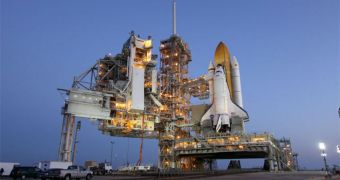A few days ago, as engineers at the Kennedy Space Center (KSC), in Cape Canaveral, Florida, were conducting tests on space shuttle Discovery, they noticed some problems with a number of valves, which appeared unable to close when commanded to do so. Manual overrides did the job, and so the team set out to investigate the cause of the malfunction. But mission managers had no way of knowing how long this was going to take, and so the orbiter's launch date was doubtful. A meeting that took place yesterday cleared the last remaining concerns, Space reports.
According to officials at NASA, the space shuttle is fit to fly on its originally-planned date of April 5, after engineers gave the go-ahead. The new flight, STS-131, will be the first of the final series of space flights the aging shuttle fleet is scheduled to perform. Only five missions to the International Space Station (ISS) were scheduled for 2010, and Endeavor already completed one earlier this year, when it delivered the Tranquility module and the seven-windowed Cupola observations dome to the facility.
“After looking at all the testing on it, we're very confident that the system will work as designed,” told reporters on Friday John Shannon, who is the shuttle program manager at NASA. The glitch that threatened Discovery's launch date was discovered in one of the shuttle's helium valves. The device is located at the back of the spacecraft, and it plays a crucial role in pressurizing the aft-mounted thrusters. The valve remained opened at all times, despite shutdown commands sent to it from the KSC control center. After inspecting the lines closely, engineers say they are confident that Discovery will be ready for its flight in time.
The orbiter is scheduled to begin its penultimate flight at 6:21 am EDT (10:21 GMT) on April 5. Once docked to the orbital facility, it will deliver new supplies and equipment, as well as the last Multi-Purpose Logistics Module (MPLM), Leonardo. Three extra-vehicular activities (EVA) will be performed during this mission, in which astronauts will use the Station's robotic arm (SSRMS) to maneuver a new ammonia tank assembly (ATA) into its position on the ISS. At the same time, they will collect the old tank, and place it into their shuttle's cargo bay, for a safe trip back home.

 14 DAY TRIAL //
14 DAY TRIAL //